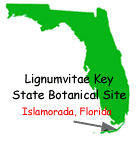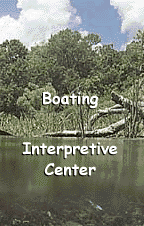
Reservations for
Florida State
Parks are now
made through
Reserve America,
toll free, at
1-800-326-3521
|
LIGNUMVITAE
KEY STATE BOTANICAL SITE
The serenity and isolation
of remote islands have always captured man's imagination. Lignumvitae
Key is no exception. To step ashore here is to take
a step back into the past. The Matheson House, built in 1919, has changed
little over the years. A windmill supplied power; fresh water was provided
from a cistern which filled by rain falling on the roof. This is how island
people lived during a simpler time when most of their needs were met by
the land and sea around them.
The
virgin tropical forest that thrives here is typical of the kind of scenery
that was once enjoyed on most of Florida's Upper Keys. As the Keys were
developed to accommodate an increasing number of people, most of the unique
vegetation was scraped away, making the tropical forest of Lignumvitae
Key a very rare and special place.
State park rangers conduct guided tours
three times daily, Thursday-Monday. Here,
you walk in the shade of trees with strange names like mastic, strangler
fig, poisonwood, pigeon plum and gumbo-limbo. Fifty people may explore the key at one time, 25 on the nature trail and
25 in the clearing. Walking shoes and mosquito repellent are recommended.
Book a trip at the MM 78.5 boat ramp. 305-664-4815.
Indian Key State Historical Site, a 12-acre island on the ocean side of
Islamorada, features ruins of a wreckers’ village burned down by
Indians in 1840 and numerous sisal plants cultivated by famed botanist,
Dr. Henry Perrine. Book a guided walking tour with the Florida Park Service
at the MM 78.5 boat ramp. 305-664-4815.
HISTORY
Thousands of years ago, the island began as a living coral reef jutting
up from the sea floor. As great quantities of water began to freeze into
glaciers at the earth's poles, the sea level dropped, exposing the top of
the reef and forming an island composed of fossilized coral rock.
As time passed, storm tides
and waves left seaweed, driftwood and other organic debris stranded on
the bare rock. This material began decaying, forming small pockets of
soil in depressions in the coral rock. Then came a few seeds from other
tropical islands, some floating on the sea or carried by the winds, while
others came in the digestive tracts of migrating birds. Here, the seeds
sprouted and began to grow, drop leaves, produce flowers and seeds, mature,
die and decay. With the passing of each generation, a complex and diverse
tropical hammock colonized the remains of this ancient coral reef.
TOURS
One-hour guided walks are given at 10:00 a.m. and 2:00 p.m., Thursday through
Monday. The tour fee is $1 per person. Children under 6 are admitted free
of charge. Access to the Key for these tours is limited to privately owned
boats or charter boats available at nearby marinas. The park is closed on
Tuesday and Wednesday. Tour boat service available. For reservations call
(305) 664-9814 or 664-4196. Tour boat departs 1/2-hour before listed tour
times.
REGULATIONS & PROTECTION
To preserve the fragile nature of the Key, visitors are required to stay
within the clearing except in the company of an interpretive guide or Park
Ranger.
- The maximum number of people
permitted on the Key at one time is 50; 25 on the trail and 25 in the
clearing.
- In order to enjoy your visit,
you should wear walking shoes and bring mosquito repellent.
- Most facilities and activities
are not accessible to the handicapped. See a Park Ranger for special
needs.
- For more information, contact
Lignumvitae Key State Botanical Site, P.O. Box 1052, Islamorada, FL
33036; (305) 664-4815.

Lignumvitae Key State Botanical Site is located one mile west of U.S.1
at Mile Marker 78.5. Access is by private boat or charter boats at
nearby marinas.
For more information, contact:
Lignumvitae Key State Botanical
Site
P.O. Box 1052
Islamorada, FL 33036
(305) 664-4815
View Larger Map
|
|




